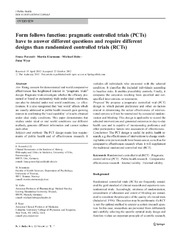Safe Learning for Control using Control Lyapunov Functions and Control Barrier Functions: A Review
Permanent link
https://hdl.handle.net/10037/23579Date
2021-10-01Type
Journal articleTidsskriftartikkel
Peer reviewed
Author
Sadanandan Anand, Akhil; Seel, Katrine; Gjærum, Vilde Benoni; Håkansson, Anne; Robinson, Haakon; Saad, AyaAbstract
Real-world autonomous systems are often controlled using conventional model-based control methods. But if accurate models of a system are not available, these methods may be unsuitable. For many safety-critical systems, such as robotic systems, a model of the system and a control strategy may be learned using data. When applying learning to safety-critical systems, guaranteeing safety during learning as well as testing/deployment is paramount. A variety of different approaches for ensuring safety exists, but the published works are cluttered and there are few reviews that compare the latest approaches. This paper reviews two promising approaches on guaranteeing safety for learning-based robust control of uncertain dynamical systems, which are based on control barrier functions and control Lyapunov functions. While control barrier functions provide an option to incorporate safety in terms of constraint satisfaction, control Lyapunov functions are used to define safety in terms of stability. This review categorises learning-based methods that use control barrier functions and control Lyapunov functions into three groups, namely reinforcement learning, online and offline supervised learning. Finally, the paper presents a discussion of the suitability of the different methods for different applications.
Publisher
ElsevierCitation
Sadanandan Anand A, Seel K, Gjærum V, Håkansson A, Robinson H, Saad A. Safe Learning for Control using Control Lyapunov Functions and Control Barrier Functions: A Review. Procedia Computer Science. 2021;192:3987-3997Metadata
Show full item recordCollections
Copyright 2021 The Author(s)
Related items
Showing items related by title, author, creator and subject.
-
The effect of metacognitive executive function training on children's executive function, proactive control, and academic skills
Kubota, Maki; Hadley, Lauren V.; Schaeffner, Simone; Könen, Tanja; Meaney, Julie-Anne; Morey, Candice C.; Auyeung, Bonnie; Moriguchi, Yusuke; Karbach, Julia; Chevalier, Nicolas (Journal article; Tidsskriftartikkel; Peer reviewed, 2023)The current study investigated the effects of metacognitive and executive function (EF) training on childhood EF (inhibition, working memory [WM], cognitive flexibility, and proactive/reactive control) and academic skills (reading, reasoning, and math) among children from disadvantaged backgrounds. Children (N = 134, Mage = 8.70 years) were assigned randomly to the three training groups: (a) ... -
Form follows function: pragmatic controlled trials (PCTs) have to answer different questions and require different designs than randomized controlled trials (RCTs)
Porzsolt, Franz; Wyers, Peter; Eisemann, Martin; Habs, Michael (Journal article; Tidsskriftartikkel; Peer reviewed, 2012)Rising concern for demonstrated real world comparative effectiveness has heightened interest in “pragmatic trials” design. Pragmatic trials investigate whether the efficacy, presumed or found in explanatory trials under ideal conditions, can also be detected under real world conditions, i.e. effectiveness. It is also recognized that ‘real world’ effects which are usually addressed in public health ... -
Form follows function: pragmatic controlled trials (PCTs) have to answer different questions and require different designs than randomized controlled trials (RCTs).
Porzsolt, Franz; Eisemann, Martin; Habs, Michael; Wyer, Peter (Journal article; Tidsskriftartikkel; Peer reviewed, 2013)Aim Rising concern for demonstrated real world comparative effectiveness has heightened interest in “pragmatic trials” design. Pragmatic trials investigate whether the efficacy, presumed or found in explanatory trials under ideal conditions, can also be detected under real world conditions, i.e. effectiveness. It is also recognized that ‘real world’ effects which are usually addressed in public ...


 English
English norsk
norsk


